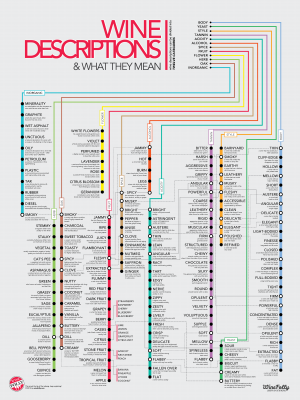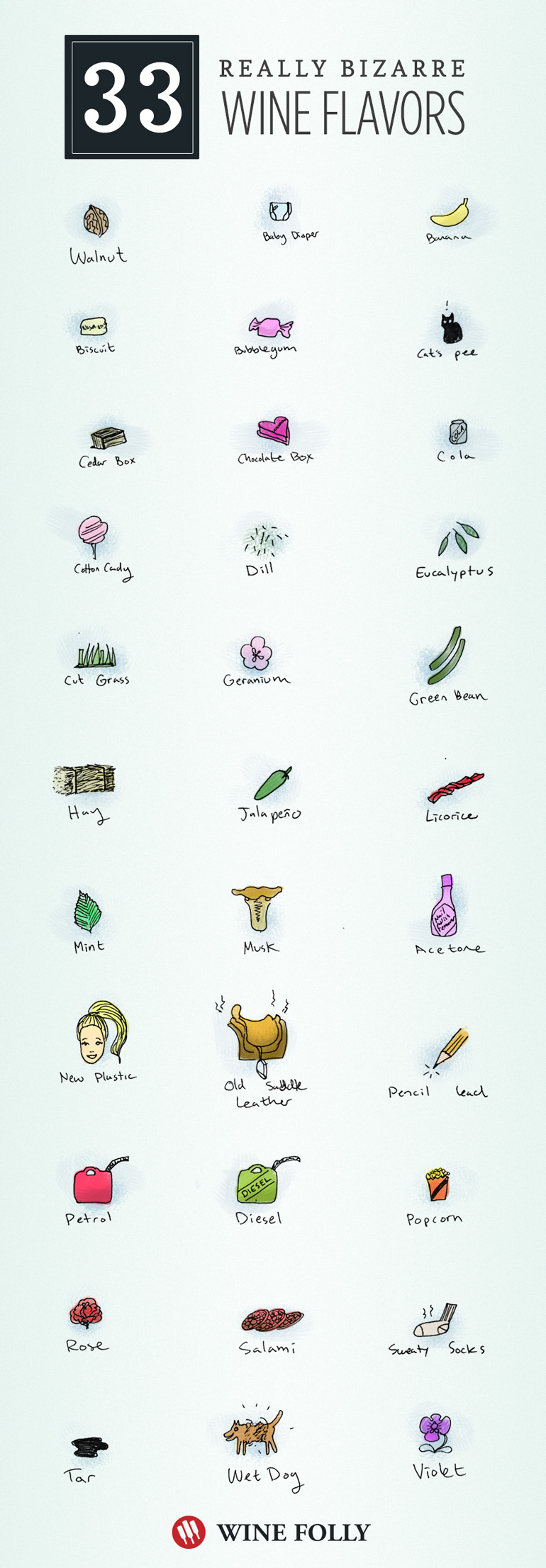See the most bizarre wine flavors and find out what wines have these flavors. If wine tasted only like flowers and fruit, it wouldn’t be as awesome as it is.
- Walnut
An aroma commonly found in aged Madeira wines, particularly Malmsey and Bual. - Banana
An aroma that comes from a winemaking process called ‘carbonic maceration’ that is most commonly associated with the red wines from Beaujolais. - Bubble gum
A very unique red wine aroma associated with light red wines from Northern Italy such as Schiava and from the red wines made of Gamay from Beaujolais made with ‘carbonic maceration’. - Cedar Box
A positive aroma associated with full-bodied red wines with moderate oak aging. Found in wines all over, but in particular Barossa Valley, Tuscany, Napa and Bordeaux. - Cola
A popular flavor found on the finish of California Pinot Noir. - Dill
An aroma that is commonly associated with American oak barrels. It’s the more extreme version of the American oak ‘coconut’ smell. - Fresh Cut Grass
A positive aroma associated with many white wines from the Loire valley. - Green Bean
A negative aroma associated with poorly made Sauvignon Blanc and other ‘green’ varieties like Grüner Veltliner and Verdejo. - Jalapeño
A very green herbaceous note associated with Sauvignon Blanc and occasionally Cabernet Franc, Cabernet Sauvignon and Camenere from cool climates. - Mint
A positive aroma of many fine red wines including Meritage (from California) and Bordeaux blends. - Nail Polish Remover
A negative aroma that is an indicator of VA (volatile acidity) in a wine. Some tasters are more sensitive to VA than others. - Old Saddle Leather
A savory and unctuous flavor found in many red wines that either have been made with more non-interventionist wine making in Italy or have brettanomyces. - Petroleum
A positive aroma associated with aged Rieslings from the Mosel in Germany and some younger examples from Italy and Australia. - Popcorn
A strong aroma associated with the ’butter’ smell (aka an aroma compound called Diacetyl) brought about from oak aging white wines. - Salami
A very meaty aroma associated with wines from Central Italy including Aglianico, particularly from Aglianico de Vulture and Taurasi. - Tar
A very rustic earthy aroma often associated with value driven wines from Tuscany, Bordeaux and La Mancha, Spain. - Wet Dog
This is a commonly associated aroma with a wine that is corked (aka exposed to TCA taint).
- Baby Diaper
A very funky oxidative smell from oak aged Chardonnay from Burgundy.
- Biscuit
A well-loved aroma associated with aged vintage Champagne and oak aged Chardonnay.
- Cat’s Pee
A negative aroma associated with white wines, particularly Sauvignon Blanc from the Loire Valley.
- Chocolate Box
A well-loved aroma found in bolder red wines from warmer climates such as South Australia, Mendoza Argentina, Central Coast California and Spain.
- Cotton Candy
A bizarre and fascinating aroma found in many lesser-known light red wine varieties from Alto Adige, Lombardy and Piedmont in Italy, such as Freisa, Brachetto d’Acqui and Schiava.
- Eucalyptus
A positive aroma associated with the red wines of South Australia and Barossa Valley. The equivalent of just a few eucalyptus leaves accidentally added to a fermenting red wine can cause this aroma.
- Geranium
A winemaking flaw distinguishable in white wines but can happen in both red and fuller-bodied white wines.
- Hay
A smell found on several white wines made in a way that exposes the must to oxygen including white Rioja, Savennieres, Sylvaner from Germany and several Portuguese white wines.
- Licorice
A primary aroma commonly associated with many Italian red wine varieties including Barbera and Nebbiolo.
- Musk
A animalistic note that smells similar to a sweet pungent sweat. This aroma is associated with many Old World red wines, especially Châteauneuf du Pape in France and Taurasi in Italy.
- New Plastic
A chemical-like aroma associated with many high acidity white wines such as Riesling and Chablis. There is no actual presence of plastic. A more extreme version of this smell is Petroleum.
- Pencil Lead
A subtle and well-appreciated aroma commonly associated with the red wines of Bordeaux and some wines of Rioja.
- Diesel
A more rustic ‘petrol’ like aroma associated with Rieslings from Australia.
- Rose
Aroma compounds called cise-rose oxide and beta-Damascenone associated with many aromatic white wines including Gewürztraminer, Moscato, and sometimes fine Pinot Noir.
- Sweaty Socks
An aroma brought about from oxidation or a strong little yeast called brettanomyces and found in many red wines all over the world and a few whites including Savennieres from the Loire Valley in France.
- Violet
An aroma associated with fine red wine blends, particularly those of Cabernet Sauvignon and Petit Verdot from Napa, Bordeaux, and Touriga Nacional in Portugal.

Understanding Wine Descriptions
Check out the infographic on wine descriptions that organizes wine words into 12 distinct categories.
